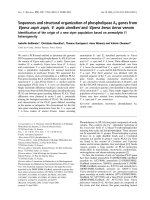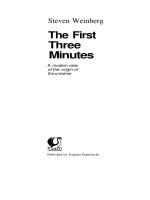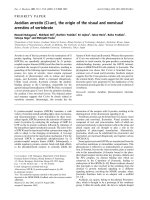The origin of species
Bạn đang xem bản rút gọn của tài liệu. Xem và tải ngay bản đầy đủ của tài liệu tại đây (1.36 MB, 55 trang )
Chapter 22
Descent with Modification: A
Darwinian View of Life
PowerPoint Lectures for
Biology, Seventh Edition
Neil Campbell and Jane Reece
Lectures by Chris Romero
Copyright © 2005 Pearson Education, Inc. publishing as Benjamin Cummings
• Overview: Darwin Introduces a Revolutionary
Theory
• A new era of biology began on November 24,
1859
– The day Charles Darwin published On the
Origin of Species by Means of Natural
Selection
Copyright © 2005 Pearson Education, Inc. publishing as Benjamin Cummings
• The Origin of Species
– Focused biologists’ attention on the great
diversity of organisms
Figure 22.1
Copyright © 2005 Pearson Education, Inc. publishing as Benjamin Cummings
• Darwin made two major points in his book
– He presented evidence that the many species
of organisms presently inhabiting the Earth are
descendants of ancestral species
– He proposed a mechanism for the evolutionary
process, natural selection
Copyright © 2005 Pearson Education, Inc. publishing as Benjamin Cummings
• Concept 22.1: The Darwinian revolution
challenged traditional views of a young Earth
inhabited by unchanging species
• In order to understand why Darwin’s ideas
were revolutionary
– We need to examine his views in the context of
other Western ideas about Earth and its life
Copyright © 2005 Pearson Education, Inc. publishing as Benjamin Cummings
• The historical context of Darwin’s life and ideas
Linnaeus (classification)
Hutton (gradual geologic change)
Lamarck (species can change)
Malthus (population limits)
Cuvier (fossils, extinction)
Lyell (modern geology)
Darwin (evolution, nutural selection)
Mendel (inheritance)
American Revolution
1750
Wallace (evolution, natural selection)
French Revolution
U.S. Civil War
1800
1850
1900
1795 Hutton proposes his theory of gradualism.
1798 Malthus publishes “Essay on the Principle of Population.”
1809 Lamarck publishes his theory of evolution.
1830 Lyell publishes Principles of Geology.
1831–1836 Darwin travels around the world on HMS Beagle.
1837 Darwin begins his notebooks on the origin of species.
1844 Darwin writes his essay on the origin of species.
1858 Wallace sends his theory to Darwin.
1859 The Origin of Species is published.
1865 Mendel publishes inheritance papers.
Figure 22.2
Copyright © 2005 Pearson Education, Inc. publishing as Benjamin Cummings
Resistance to the Idea of Evolution
• The Origin of Species
– Shook the deepest roots of Western culture
– Challenged a worldview that had been
prevalent for centuries
Copyright © 2005 Pearson Education, Inc. publishing as Benjamin Cummings
The Scale of Nature and Classification of Species
• The Greek philosopher Aristotle
– Viewed species as fixed and unchanging
• The Old Testament of the Bible
– Holds that species were individually designed
by God and therefore perfect
Copyright © 2005 Pearson Education, Inc. publishing as Benjamin Cummings
• Carolus Linnaeus
– Interpreted organismal adaptations as
evidence that the Creator had designed each
species for a specific purpose
– Was a founder of taxonomy, classifying life’s
diversity “for the greater glory of God”
Copyright © 2005 Pearson Education, Inc. publishing as Benjamin Cummings
Fossils, Cuvier, and Catastrophism
• The study of fossils
– Helped to lay the groundwork for Darwin’s ideas
• Fossils are remains or traces of organisms
from the past
– Usually found in sedimentary rock, which appears
in layers or strata
Figure 22.3
Copyright © 2005 Pearson Education, Inc. publishing as Benjamin Cummings
• Paleontology, the study of fossils
– Was largely developed by French scientist
Georges Cuvier
• Cuvier opposed the idea of gradual
evolutionary change
– And instead advocated catastrophism,
speculating that each boundary between
strata represents a catastrophe
Copyright © 2005 Pearson Education, Inc. publishing as Benjamin Cummings
Theories of Gradualism
• Gradualism
– Is the idea that profound change can take
place through the cumulative effect of slow but
continuous processes
Copyright © 2005 Pearson Education, Inc. publishing as Benjamin Cummings
• Geologists Hutton and Lyell
– Perceived that changes in Earth’s surface can
result from slow continuous actions still
operating today
– Exerted a strong influence on Darwin’s thinking
Copyright © 2005 Pearson Education, Inc. publishing as Benjamin Cummings
Lamarck’s Theory of Evolution
• Lamarck hypothesized that species evolve
– Through use and disuse and the inheritance of
acquired traits
– But the mechanisms he proposed are
unsupported by evidence
Figure 22.4
Copyright © 2005 Pearson Education, Inc. publishing as Benjamin Cummings
• Concept 22.2: In The Origin of Species, Darwin
proposed that species change through natural
selection
• As the 19th century dawned
– It was generally believed that species had
remained unchanged since their creation, but a
major change would challenge this thinking
Copyright © 2005 Pearson Education, Inc. publishing as Benjamin Cummings
Darwin’s Research
• As a boy and into adulthood, Charles Darwin
– Had a consuming interest in nature
• Soon after Darwin received his B.A. degree
– He was accepted on board the HMS Beagle,
which was about to embark on a voyage
around the world
Copyright © 2005 Pearson Education, Inc. publishing as Benjamin Cummings
The Voyage of the Beagle
• During his travels on the Beagle
– Darwin observed and collected many
specimens of South American plants and
animals
• Darwin observed various adaptations of plants
and animals
– That inhabited many diverse environments
Copyright © 2005 Pearson Education, Inc. publishing as Benjamin Cummings
• Darwin’s interest in the geographic distribution
of species
– Was kindled by the Beagle’s stop at the Galápagos
Islands near the equator west of South America
England
NORTH
AMERICA
EUROPE
ATLANTIC
OCEAN
PACIFIC
OCEAN
Galápagos
Islands
AUSTRALIA
Cape of
Good Hope
Cape Horn
Figure 22.5
HMS Beagle in port
SOUTH
AMERICA
Andes
Darwin in 1840,
after his return
AFRICA
Tierra del Fuego
Copyright © 2005 Pearson Education, Inc. publishing as Benjamin Cummings
Tasmania
New
Zealand
Darwin’s Focus on Adaptation
• As Darwin reassessed all that he had observed
during the voyage of the Beagle
– He began to perceive adaptation to the
environment and the origin of new species as
closely related processes
Copyright © 2005 Pearson Education, Inc. publishing as Benjamin Cummings
• From studies made years after Darwin’s
voyage
– Biologists have concluded that this is indeed
what happened to the Galápagos finches
(a)
Cactus eater. The long,
sharp beak of the cactus
ground finch (Geospiza
scandens) helps it tear
and eat cactus flowers
and pulp.
Figure 22.6a–c
(c)
(b)
Seed eater. The large ground
finch (Geospiza magnirostris)
has a large beak adapted for
cracking seeds that fall from
plants to the ground.
Insect eater. The green warbler
finch (Certhidea olivacea) uses its
narrow, pointed beak to grasp insects.
Copyright © 2005 Pearson Education, Inc. publishing as Benjamin Cummings
• In 1844, Darwin wrote a long essay on the
origin of species and natural selection
– But he was reluctant to introduce his theory
publicly, anticipating the uproar it would cause
• In June 1858 Darwin received a manuscript
from Alfred Russell Wallace
– Who had developed a theory of natural
selection similar to Darwin’s
• Darwin quickly finished The Origin of Species
– And published it the next year
Copyright © 2005 Pearson Education, Inc. publishing as Benjamin Cummings
The Origin of Species
• Darwin developed two main ideas
– Evolution explains life’s unity and diversity
– Natural selection is a cause of adaptive
evolution
Copyright © 2005 Pearson Education, Inc. publishing as Benjamin Cummings
Descent with Modification
• The phrase descent with modification
– Summarized Darwin’s perception of the unity
of life
– States that all organisms are related through
descent from an ancestor that lived in the
remote past
Copyright © 2005 Pearson Education, Inc. publishing as Benjamin Cummings
• In the Darwinian view, the history of life is like a tree
Sirenia
Hyracoidea (Manatees
(Hyraxes) and relatives)
Figure 22.7
Copyright © 2005 Pearson Education, Inc. publishing as Benjamin Cummings
Mammuthus
Stegodon
Platybelodon
Mammut
Barytherium
Deinotherium
Elephas Loxodonta Loxodonta
maximus africana
cyclotis
(Africa)
(Asia)
(Africa)
Moeritherium
Millions of years ago
Years ago
– With multiple branchings from a common trunk
to the tips of the youngest twigs that represent
the diversity of living organisms
Natural Selection and Adaptation
• Evolutionary biologist Ernst Mayr
– Has dissected the logic of Darwin’s theory into
three inferences based on five observations
Copyright © 2005 Pearson Education, Inc. publishing as Benjamin Cummings









